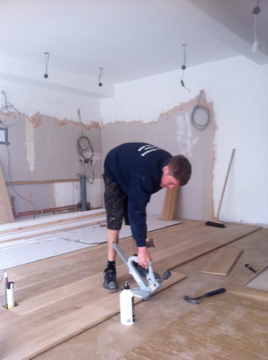Blog
Why You Must Use Low Tog Rugs with Engineered Oak Wood Flooring Over Water-Based Underfloor Heating

Wood floor fitting using Porta nailer mechanically fixing wood flooring
Why You Must Use Low Tog Rugs with Engineered Oak Wood Flooring Over Water-Based Underfloor Heating
With over 15 years in the UK wood flooring industry, one topic that continues to cause confusion—and sometimes costly damage—is the use of rugs over engineered wood flooring installed on water-based underfloor heating (UFH). If you’re planning to install or already enjoy the beauty of engineered oak wood flooring over underfloor heating, this article is essential reading.
Why Low Tog Rugs Matter Over Engineered Wood Flooring and UFH
Engineered oak flooring is widely celebrated for its stability, warmth, and timeless elegance. When paired with water-based UFH systems, it offers consistent heat distribution and energy-efficient comfort. However, placing rugs over this flooring can disrupt the delicate balance of heat transfer—unless those rugs meet specific thermal resistance criteria.
Rugs with high thermal resistance, also known as high ‘tog’ ratings, act as insulators. While this might sound beneficial, in practice, it prevents heat from transferring effectively into the room. This trapped heat accumulates beneath the rug and, over time, can:
Overheat the flooring:
Engineered oak is more stable than solid wood, but it still has limits. Prolonged exposure to excessive heat can cause boards to dry out, warp, or develop gaps.
Trigger adhesive failure:
If your engineered flooring is glued down, elevated temperatures can weaken the bond, causing lifting or cupping.
Cause uneven heating and system inefficiency:
UFH systems rely on open, even surfaces to function optimally. High-tog rugs can make your system work harder, reducing its lifespan and efficiency.
What Is a Safe Tog Rating for Rugs Over Underfloor Heating?
The rule of thumb is simple: any rug used over engineered wood flooring and UFH should have a combined tog rating of 1.5 or less. That includes the rug and any underlay used beneath it.
For example:
A thin cotton rug (~0.5 tog) paired with a breathable anti-slip underlay (~0.5–0.8 tog) is usually acceptable.
A thick wool rug with dense foam underlay (~2.0+ tog) is not safe and should be avoided.
Dispensations for Passive and Super-Insulated Homes
If you live in a Passive House or a similarly high-performance, airtight home with exceptional insulation, you may have more leeway. In these homes, the demand on your UFH system is much lower, and surface temperatures tend to remain moderate. While it’s still advisable to choose low tog rugs, short-term use of higher-tog options in specific areas (like beside the bed) may be tolerable—as long as you monitor floor temperatures to ensure they remain within manufacturer-recommended ranges, typically below 27°C.
Homeowner-Friendly Checklist: Choosing Rugs Safe for Engineered Wood Flooring and Underfloor Heating
Use this quick checklist when rug shopping:
✅ Check the rug’s tog rating – Aim for rugs rated 1.0 tog or less.
✅ Choose breathable materials – Cotton, jute, or low-pile synthetic fibres are usually safer.
✅ Avoid dense foam backings or rubber mats – These restrict airflow and trap heat.
✅ Select breathable underlay – Use mesh, felt, or purpose-designed UFH-compatible rug pads.
✅ Use a floor thermometer – Periodically check the temperature beneath the rug.
✅ Avoid overlapping multiple rugs – Layering increases the overall tog and heat resistance.
✅ Stick to UFH-compatible labels – Many manufacturers now label rugs as “underfloor heating safe.”
✅ Reposition rugs occasionally – This prevents any one section of flooring from prolonged high heat exposure.
Final Thoughts
Installing engineered oak wood flooring with underfloor heating is an excellent investment in comfort, efficiency, and style. But to protect that investment, it’s vital to make informed choices when selecting rugs. Choosing low tog rugs isn’t just a technical requirement—it’s a simple step that can prevent long-term damage and preserve the integrity of your beautiful flooring.
If in doubt, consult with your flooring supplier or installer. And remember: a well-informed homeowner is the best kind.

